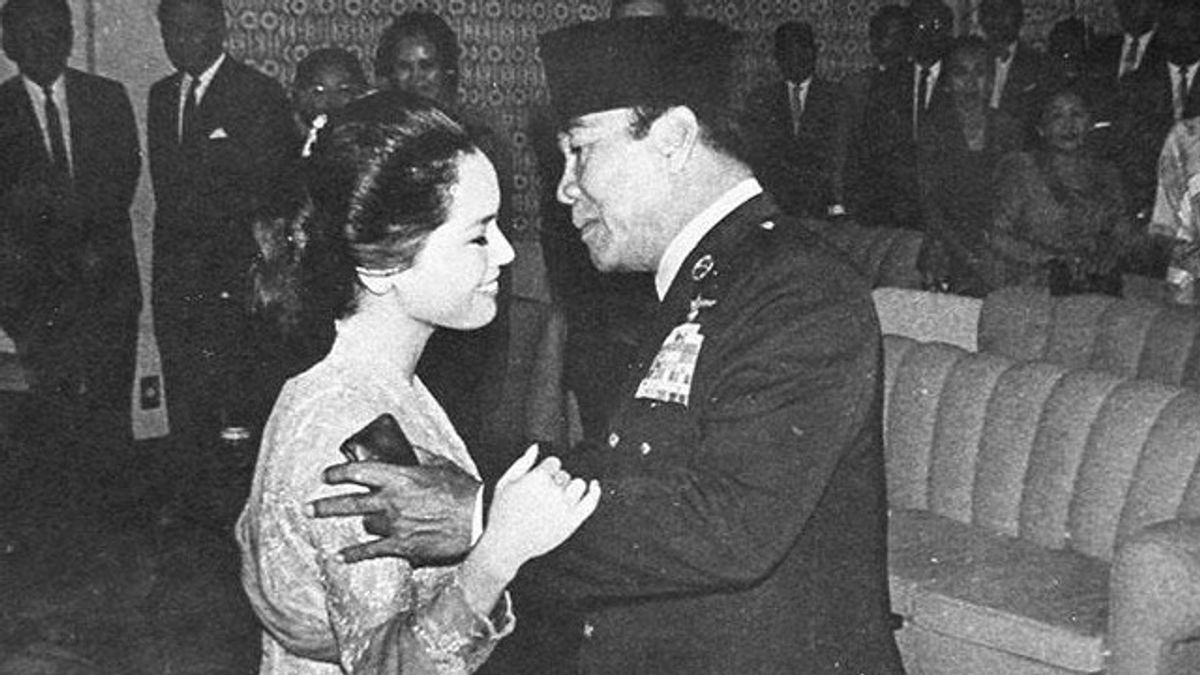JAKARTA - The life of Ratna Sari Dewi cannot be far from controversy. Her decision to become Soekarno's fifth wife invited a lot of criticism. His nationality, past, and lifestyle are often questioned. Moreover, both of them got married in the middle of the economic downturn of the Old Order. There were voices of protest. Sometimes to Ratna Sari Dewi. Sometimes also to Soekarno.
But his love story is always awaited by the public alias sold out. The evidence implies that both of them are not only hated, but also missed. After independence, Indonesia and Japan were close in terms of advancing culture and the arts. Thanks to that, Bung Karno had many opportunities to visit the Land of the Rising Sun.
During one of his visits, Bung Karno first met a beautiful woman at a dinner at the Imperial Hotel, Tokyo in 1959. That woman was Naoko Nemoto. The encounter made Soekarno happy, not playing. Bung Karno admired many things related to Naoko's personality.
In fact, meeting a woman who was still 19 years old in Bung Karno's eyes was like destiny. Because, both have the same interest: art. Naoko loves the art world as a whole. He likes literature, is good at dancing, has a talent for singing and has an interest in the world of painting. Bung Karno then had a desire to marry her.
“And the alliance ended with another, more romantic 'union', when he married Naoko Nemoto on March 3, 1962. Naoko, born in Tokyo on February 6, 1940, is a beautiful girl who loves to paint and wants to become a painter. He also aspires to be a writer and literary critic. He also likes to sing and dance classical Japanese. Even playing a drama at the Sishere Hayakama Art Production association in Tokyo.”
“Bung Karno, who first met Naoko at the Imperial Hotel Tokyo, admitted that it was not only the beauty of the Japanese girl that made him fall in love. However, more than anything else, it is Naoko's passion and infatuation with art that ensnares her. So Bung Karno was forced to apply with pearls of wisdom: Be you the source of my inspiration and strength,” wrote Agus Dermawan T in the book Hills of Attention: From Political Artists, False Paintings to Bung Karno's Art Cosmology (2004).

Soekarno and Ratna Sari Dewi (Source: National Library)
After getting married, Naoko Nemoto was given a new name by Bung Karno: Ratna Sari Dewi. The new name implies the meaning that Naoko has just been reborn into the world. Their lives then began to flow with happiness. Even so, his marriage did not erase the dark story of Ratna Sari Dewi. The mother of Ratna Sari Dewi was strongly against her daughter's wedding plans. Then, 26 hours after getting married he got two sad news at once. His mother and sister, Yasso, have passed away.
“I lost my whole family. My widowed mother was not happy with my marriage. Right after I converted to Islam and married the president, he died of a heart attack. On the same day, my only brother, Yasoo committed suicide. Within 26 hours I lost everything. I don't have anyone else, except Bung Karno," said Ratna Sari Dewi as written by Cindy Adams in the book My Friend The Dictator (1967).
The loss of two people who are loved directly is clearly hard for Ratna Sari Dewi. That's where the charismatic Bung Karno came into play. Soekarno became solace. In order to cure Ratna Sari Dewi's sadness, Bung Karno designed the house that Ratna Sari Dewi would later occupy on Jalan Gatot Soebroto: Wisma Yasoo (now: Museum Satriamandala).
Right on June 6, 1962, or Soekarno's 61st birthday, he also wrote a special will for Ratna Sari Dewi. It contained Sukarno wanted to live and die with Ratna Sari Dewi. "If I die, bury me under a shady tree. I have a wife who I love with all my soul, her name is Ratna Sari Deui. When she dies, bury her in my grave too. I always want her to be with me," said Bung Karno's will .
Hate you but miss youSince the beginning of the marriage between Ratna Sari Dewi and Bung Karno was only known to a limited circle. The first to feel Soekarno's suspicion of marrying Ratna Sari Dewi was Haryati, who was actually the sixth wife. Haryati did not know exactly when Ratna Sari Dewi came to Indonesia, between 1959 or 1961. However, she began to smell Ratna Sari Dewi's presence since 1964.
“I am burdened by various considerations. How exactly is this father (Soekarno), why do you have another wife, what's all this for, then several other beautiful women appear. I'm not jealous of beautiful women. Because nowadays there are indeed many beautiful women, but as a wife this feeling of insecurity comes, until finally one day I took the road, among other things, asking which one is my personal garwo. And my father said the others were not official,” said Haryati in Bung Karno's book: The Gone of a Lover, My Husband, & My Pride (1978).
Gradually, the public then heard rumors of Bung Karno marrying a Japanese woman. In fact, the public had previously been disappointed by Bung Karno for doubling Fatmawati by marrying Hartini. At its peak, the student demonstrations in 1966 focused on Bung Karno's "workman" marriage.

Ratna Sari Dewi is one of the wives who are being criticized by students. The many messages "Stop importing wives" on the streets of the capital are proof of that. Those words clearly refer to Soekarno's wife of Japanese blood, Ratna Sari Dewi. The rudeness of the students led to the lifestyle of Bung Karno's wives who were luxurious with all the facilities. However, they are not sensitive to the difficult conditions of the Indonesian people.
From then on, the public began to be skeptical about the figure of Ratna Sari Dewi. This is because there is no Indonesian press that has thoroughly reviewed Ratna Sari Dewi. As for some photos of Ratna Sari Dewi that exudes the beauty of her face spread in the public, it adds to the curiosity of the audience. That's where the public seems to not really hate the two of them, but there is also public admiration for Ratna Sari Dewi. Because of that, when one of the mass media published the story of Ratna Sari Dewi in depth, the newspaper or magazine immediately sold out.
“The response to Madjalah Sunda which contains an article about Ratna Sari Dewi has been extraordinary. In an instant the magazine was sold out, and was retailed outside for ten times the official price. If it is now I will surely reprint it as much as possible. But at that time, offset printing had not yet been invented, so reprinting in a relatively short time was impossible because printing still used tin which was set on the Linotype or Intertype machine, which after printing is usually immediately melted down again," concluded Sastrawan Ajip Rosidi in his book Life Without Diploma. (2008).
*Read other information about HISTORY or read other interesting articles from Detha Arya Tifada.
Other BERNASThe English, Chinese, Japanese, Arabic, and French versions are automatically generated by the AI. So there may still be inaccuracies in translating, please always see Indonesian as our main language. (system supported by DigitalSiber.id)









